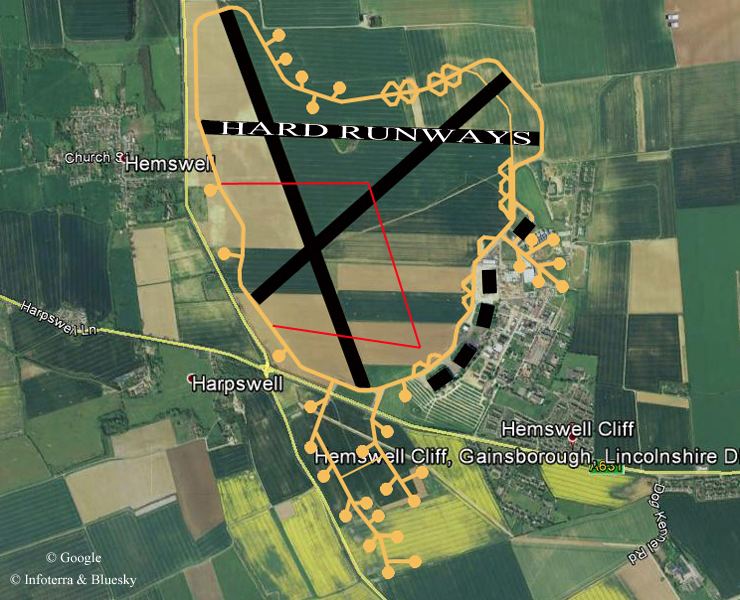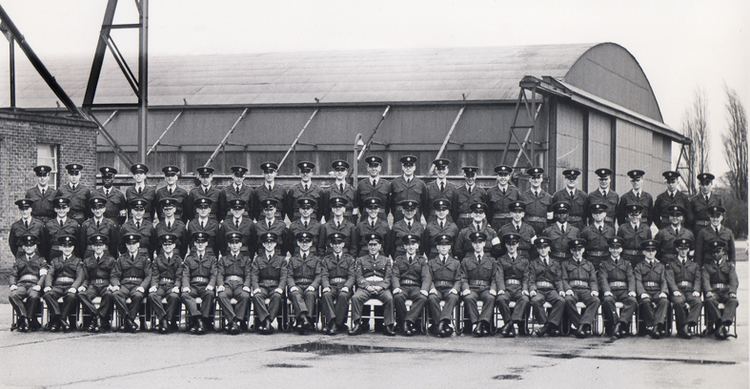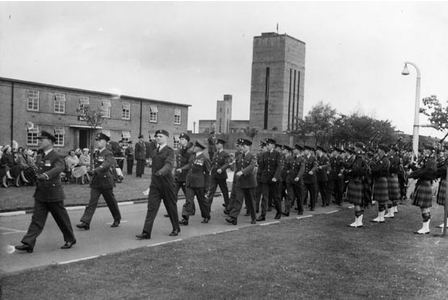Airport type Military | Elevation AMSL 177 ft / 54 m | |
 | ||
Operators | ||
Raf hemswell
Royal Air Force Station Hemswell or more simply RAF Hemswell is a former Royal Air Force station located 7.8 miles (12.6 km) east of Gainsborough, Lincolnshire, England.
Contents
- Raf hemswell
- Quadcopter flight tbs discovery at raf hemswell lincoln
- First World War
- Second World War
- Cold War
- In popular culture
- Squadrons and units located at RAF Hemswell
- After closure
- 2009 Fire
- Reasons for Designation
- References

Located close to the village of Hemswell in Lincolnshire, England the disestablished airfield is now in full use as a civilian industrial and retail trading estate, forming part of the newly created parish of Hemswell Cliff along with the station's married quarters and RAF built primary school that are now in non-military ownership.

The airfield used by RAF Bomber Command for 20 years between 1937 and 1957 and saw most of its operational life during the Second World War. Later used again by RAF Bomber Command as a nuclear ballistic missile base during the Cold War it closed to military use in 1967.

On 19 March 1940 RAF Hemswell-based Handley Page Hampdens of No. 61 Squadron RAF were the first Bomber Command aircraft to drop bombs on German soil during the Second World War. The target was the Hörnum seaplane base on the northern Germany coast.
RAF Hemswell was immortalised on film when it was used as a substitute for RAF Scampton in all the ground based filming of the 1954 war film The Dambusters.
Quadcopter flight tbs discovery at raf hemswell lincoln
First World War
The first airfield on the site was opened in 1918 by the Royal Flying Corps and called RFCS Harpswell after the village of that name just across the A631 road.
During the First World War it was used as a night landing ground and two night flying training squadrons were established there. In June 1919 the grass airfield was returned to its former use as farmland.
Second World War
In 1935 construction began on compulsory repurchased land. The new bomber airfield, now called RAF Hemswell, was opened on New Year's Eve 31 December 1936 to accommodate the rapidly expanding Bomber Command. The station was home for Hawker Hind, Hawker Audax, Avro Anson, Bristol Blenheim and Boulton Paul Overstrand aircraft in its early days.
On 19 March 1940 RAF Hemswell-based Handley Page Hampdens of No. 61 Squadron RAF were the first Bomber Command aircraft to drop bombs on German soil during the Second World War. The target was the Hörnum seaplane base on the northern Germany coast.
The station and its squadrons (61 and 144) initially formed part of No. 5 (Bomber) Group RAF with its group headquarters at St Vincents House, St Vincents Road, Grantham, transferring to No. 1 Bomber Group RAF at RAF Hucknall, Nottinghamshire in June 1941.
During the war years various squadrons were posted to Hemswell, including many Polish personnel flying Vickers Wellingtons. During the war a total of 122 bomber aircraft and their crews were lost on operations from Hemswell, including 38 Handley Page Hampdens, 62 Vickers Wellingtons and 22 Avro Lancasters.
Hemswell operated as a dual site with a nearby overflow airfield at RAF Ingham. RAF Ingham was a grassed field landing ground with few buildings or facilities. Between 1941 and 1943 the Polish bomber squadrons (No. 305 Polish Bomber Squadron, No. 301 Polish Bomber Squadron and No. 300 Polish Bomber Squadron) used the airfield for their Wellington operations. The squadrons used Ingham while training and also flew operations from there whilst the runways were being laid at Hemswell in anticipation of the arrival of the heavier Avro Lancaster. Ingham was later renamed RAF Cammeringham and became a full station in its own right, closing for aircraft use in 1945 when the grass runways became unstable and taking on a ground training role. Cliffe House, that had been commandeered as the officers' mess and a number of pre-fabricated buildings, quonset huts and the brick built control tower still stand at the abandoned airfield.
With the arrival of the Avro Lancaster, Hemswell took on a training role, becoming the home to No 1 Lancaster Finishing School. This school was tasked with giving Lancaster experience to aircrews who had just finished their training at a Heavy Conversion Unit prior to posting to an operational squadron. During 1944, as Lancasters were then being used at Heavy Conversion Units, the Lancaster Finishing Schools were disbanded and Hemswell again took on an operational role. No 150 and 170 squadrons took up residence and commenced flying bomber operations until the end of the war. The film "Night Bombers" which is available on DVD and video was shot at Hemswell during this period.
Cold War
After the war a variety of aircraft were stationed at Hemswell including de Havilland Mosquitos, Avro Lancasters and Lincolns, English Electric Canberras with various peacetime roles undertaken including ex-prisoner-of-war repatriation, the dropping of food supplies during the relief of Holland and the Berlin Blockade, goodwill visits to foreign countries, electronic counter measures and nuclear air sampling over hydrogen bomb test sites in the Pacific and Australia.
Hemswell continued in operational flying use by RAF Bomber Command until as late as 1956. The last flying squadrons had departed in January of that year but RAF Hemswell was then established as an RAF Bomber Command missile unit, maintaining and operating threeThor Intermediate Range Ballistic Nuclear Missile launchers of No 97 (Strategic Missile) Squadron RAF that remained at Hemswell from December 1959 to May 1963.
Each missile was tipped with a one-megaton nuclear warhead, jointly controlled by the Royal Air Force and the United States Air Force under the so-called dual-key arrangements. RAF Hemswell was also the headquarters for the No 5 (Lincolnshire) Missile Dispersal Sites located at RAF Bardney, RAF Caistor, RAF Coleby Grange and RAF Ludford Magna. The Cuban Missile Crisis brought the entire UK based Thor missile force to maximum strategic alert and readiness for a ten-day period during October and November 1962.
In 1964 the station was designated and prepared as an operational conversion unit for the expected deployment of the planned TSR-2 (Tactical Strike and Reconnaissance)aircraft. But when the TSR-2 programme was cancelled by the government in 1965, Hemswell had a brief existence as a sub site of 7 School of Recruit Training whose headquarters were at RAF Swinderby. Recruit training continued from Hemswell but the station was eventually placed on "Care and Maintenance" in 1967, when it was decided that all future recruit training would be carried out at RAF Swinderby.
During 1967 the gliders of 643 gliding school Air Training Corps moved in from Kirton in Lindsey. No 643 GS operated from Hemswell until 1974, giving ATC cadets air experience and glider pilot training until moving to RAF Lindholme on 1 April 1974.
This event marked the last RAF use of the airfield which closed and was largely sold with the runways being broken up and used as hardcore for the extension of the A180 road. For several years the buildings were occupied by Ugandan nationals expelled from their country by Idi Amin.
In April 1985 the entire technical site including the barrack blocks were sold to Roger Byron-Collins company The Welbeck Estate Group by tender. In 1986 the group sold the individual buildings by auction which took place in the Airmens Mess and as a result, with the creation of many new businesses it was renamed The Caenby Corner Estate. In addition in 1989 the same company purchased a large number of the post war NCO married quarters. Welbeck also acquired the nearby Bomber/Strike Command Headquarters at RAF Bawtry in 1987 and entire Married Quarter sites also nearby at RAF Scampton, RAF Finningley and RAF Cranwell.
Throughout the years of operation, RAF Hemswell's mascott and motto were a large weasel rearing-up on its hind legs ready to strike and the words "Bold and Tenacious" emblazoned over (or under) it.
In popular culture
Hemswell was used as a substitute for RAF Scampton in the ground based filming of the 1954 film The Dam Busters as the wartime layout of both Scampton and Hemswell was similar in many places. The film "Night Bombers" remains the best known filmed record of what RAF Hemswell looked like during and just after the war, which is a colour film of Avro Lancasers at Hemswell in preparation for a raid over Germany which shows briefings, loading of bombs and the raid itself and was the only known colour film of Lancasters at War. Scenes for the Dambusters film were filmed in various offices of the station headquarters; the front entrance, the bedrooms, ante room and dining room of the officers' mess; hangars and the NAAFI canteen with the latter used for the squadron briefing theatre scenes, as well as on the roadways within the base.
The similarities between Scampton and Hemswell continue to cause confusion. It has been said that, at the end of the film actor Richard Todd can be seen walking up the main driveway at Hemswell past Gibson House in the direction of the hangar line; this scene was in fact shot at Scampton.
At the time of filming R.A.F. Hemswell operated Avro Lincolns, very similar in design to The Lancaster and several of these aircraft appeared in background shots during filming, doubling for additional No 617 Squadron Lancasters, as the filmmakers only had three airworthy and fully flying Lancasters available to them.
Squadrons and units located at RAF Hemswell
No. 542 Operating Canberras in the Nuclear Test (USSR's not ours) Sampling Role. 31 March 1957 from Weston Zoyland. 11 July 1958 TO Upwood
After closure
In 1972 the station became the temporary Hemswell Resettlement Camp when it received Ugandan-Asian refugees expelled from Uganda by president Idi Amin.
After Hemswell closed the site was eventually redeveloped into a private trading estate and residential area with the former estates of officers' and other ranks' married quarters becoming what is now the new civil parish and village of Hemswell Cliff. The wartime station headquarters building still stands on the new trading estate and is called Gibson House. It is used by a number of companies as office space. Hemswell almost uniquely amongst the wartime flying stations has retained its pre-war road layout, most of its buildings and an almost "RAF feel", despite being in private ownership.
Two short lengths of the original metalled runways still exist, used as farm machinery hardstanding, as do most of the hangars and station buildings which have been pressed into alternate uses by private companies. Until 2006 a private aviation museum displayed a small collection of ex-RAF aircraft on a grassed area behind the old Station Headquarters, including two Hawker Hunters, a BAC Jet Provost, a de Havilland Vampire, an English Electric Canberra and an English Electric Lightning. The museum closed and the collection has either been dispersed to other museums or broken up for spares and scrap.
The station is now totally civilian, however, the RAF still own the community centre and have spent considerable money refurbishing it. The old H Block other rank accommodation buildings on the site have now become home to one of Europe's largest antique centres and there are also various shops, the original RAF Hemswell Post Office, a garden centre, hairdresser, used book shop and several cafés. On Sundays there is a very large Sunday market and car boot sale. Hemswell Cliff Primary School, formally the RAF primary school, still serves the children of the nearby communities. The former station officers' mess is now known as Hemswell Court and provides an elegant venue for weddings, banqueting and conference facilities. The Hemswell hangars have been pressed into service as European Union Common Agricultural Policy Intervention Stores on several occasions as a Lincolnshire location for the occasional EU "grain mountain" excesses.
The non-profit RAF Hemswell Association's membership is open to all ranks and trades who served at Hemswell any time between 1937 and 1967. There is an annual reunion at Hemswell and the association also publishes a bi-annual magazine. Annual subscriptions are currently set at £7.
There have also been several cases of unexplained occurrences and cases of ghostly music being heard, where no music should be.
2009 Fire
In August 2009 there was a large fire at one of the former RAF hangars that was being used as a plastics recycling site by AWS Eco-plastics. Several propane gas cylinders exploded and as a result of the intensity of the fire the A631 had to be closed from Harpswell Hill to Caenby Corner.
Listed buildings
On 4 November 2016, Historic England announced that the former Officer's mess of RAF Hemswell was to be listed with Grade II status (listing 1435888). Opened in 1936, the mess was converted to hotel in the 1980's and is now known as Hemswell Court hotel. The following is a list of reasons the hotel was so designated, a tribute to how the current owners have maintained the site.
Reasons for Designation *
The former RAF Officers’ Mess built in 1935 and opened in 1936, which was converted to a hotel in the 1980s, is listed at Grade II for the following principal reasons:
* Architectural interest: it has a fine neo-Georgian composition with carefully judged proportions and good quality building materials;
* Interior: the interior treatment displays the spatial quality and understated refinement typical of the neo-Georgian idiom;
* Degree of survival: the layout, fixtures and fittings of the reception rooms in the central range survive with a high degree of intactness, and overall the external composition and configuration remains close to its original form;
* Historic interest: it is a well preserved example of its type, that encapsulates the aims of the post-1934 Expansion Period in the lead up to World War II. It was home to two of the squadrons that were involved in the earliest action of the war, and featured prominently in the acclaimed 1954 film The Dam Busters;
* Context: it retains its immediate contemporary setting, character and relationship to other buildings, including the carefully designed layout of the tree-lined approach road and the green around which the Officers’ housing is arranged.
Other applications for listing are in the process of being made for the main site,
